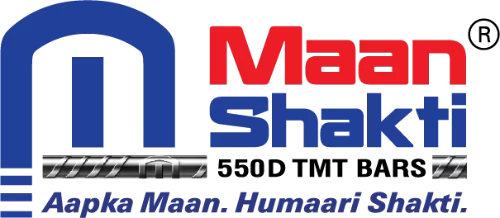India’s construction industry holds prospects for greater economic contribution in the coming years. As architectural innovation flourishes, so do the risks of climate change and natural disasters. Urbanisation performed across the nation has been massively supported by highly resilient construction materials. Thermo-mechanically treated (TMT) Bars are one such innovation that has empowered India’s construction sector.
We at Maan Shakti function as the best-quality TMT Bar manufacturers in Assam and West Bengal. But what exactly makes our TMT Bars stand out? Our three-stage Manufacturing Process ensures high quality and increases performance excellence.
In this blog, we’ll discuss how the three stages of TMT manufacturing are executed and why they are essential for your buildings and bridges.
The 3-Stage TMT Manufacturing Process: Concept and Benefits
1. Sourcing Raw Materials and Melting
Our first stage for TMT bar manufacturing involves sourcing raw materials from high-grade steel bars. We check the quality of each steel bar, sort it, and select TMT bars.
After sourcing, we proceed with the melting process. During the melting stage, the main iron ore and impurities are gradually separated. Our highly advanced spectrometer accurately measures each chemical component to identify the purity of our TMT bars.
As the top TMT company in Assam, we ensure consistent quality checking during material selection and the melting process. A series of quality checks increases the sturdiness and resilience of the final product outputs.
2. Casting and Making Steel Billets
Continuous Casting is crucial to constructing TMT bars and is a significant reason behind our bars’ resilience. We include an Automated continuous casting Machine to maintain the cycle in TMT manufacturing. With an advanced casting machine, we have revolutionised the steel production process by enhancing quality and strength.
Once the casting process is completed, we proceed to manufacturing steel billets. For sequencing, the temperature in our rolling mills ranges from 1200 degrees to 1300 degrees Celcius. As the best TMT Steel manufacturers in West Bengal, we evaluate and modify the temperature-controlling process to enhance heat resistance in the TMT steel.
Greater temperature control helps the steel to turn into a ferrite pearlite structure. As a result, the core of our TMT bars gets more robust while the inner core remains soft.
3. Thermo-Mechanical Treatment
Here comes the final stage of Thermo-Mechanical Treatment. This process is further segregated into three main stages such as Quenching, Self-Tempering and Cooling. Unlike regular steel bars, Thermo-Mechnical Treatment increases core sturdiness with the steel rods. Here’s how each stage can improve quality and resilience.
Quenching
We extensively use the Thermex System to perform the heat-quenching process. As the hot-rolled steel bars are extracted from the rolling mill, they enter a water spray called the Thermex System.
The Thermex process helps the outer layer of steel bars decrease rapidly, making it harder. Meanwhile, the inner core gains bendability properties, making the TMT Bar highly ductile. Highly ductile TMT bars are preferred across construction industries as resilient items that can withstand extreme pressure.
Self-Tempering
After the quenching process is completed, heat present in the inner core of the TMT bars gets transferred to the outer core. This transfer of heat across steel surfaces is known as Tempering.
As the top TMT company in Assam, we prefer a self-tempering process. This strengthens the inner structure of TMT bars while making the outer core heat resistant.
Cooling
We prefer atmospheric temperature for cooling our TMT bars. As our TMT bars come in contact with atmospheric air, the austenitic core of our bars turns into a ferrite-pearlite structure. This increases the weldability of our TMT bars and thereby improves the resilience of your construction.
Why Core Resilience Matters?
Core Resilience is what makes your TMT bars last longer. The soft inner cores of TMT bars have high bendable properties, which makes them suitable for complex architectural designs. Whereas, strong and hard outer core can withstand pressure on the external surface.
Strong property of the outer core helps us to include cross-ribbed designs on the TMT bar surface. As the best TMT Steel bar manufacturers in West Bengal, cross-ribbed structures increases concrete gripping abilities. If your concrete is well-protected, your building will stay safe from seismic shocks.
Key Takeaways
Thermo-Mechnical Treatment have redefined quality of steel bars, making them highly resilient. Our TMT Bars are designed to protect your building structure against earthquakes and other natural disasters. At Maan Shakti, we offer you only with the top-quality products for diverse architectural requirements.
If your construction project demands innovation, our resilient TMT Bars will offer you with the best support.


Leave a Reply